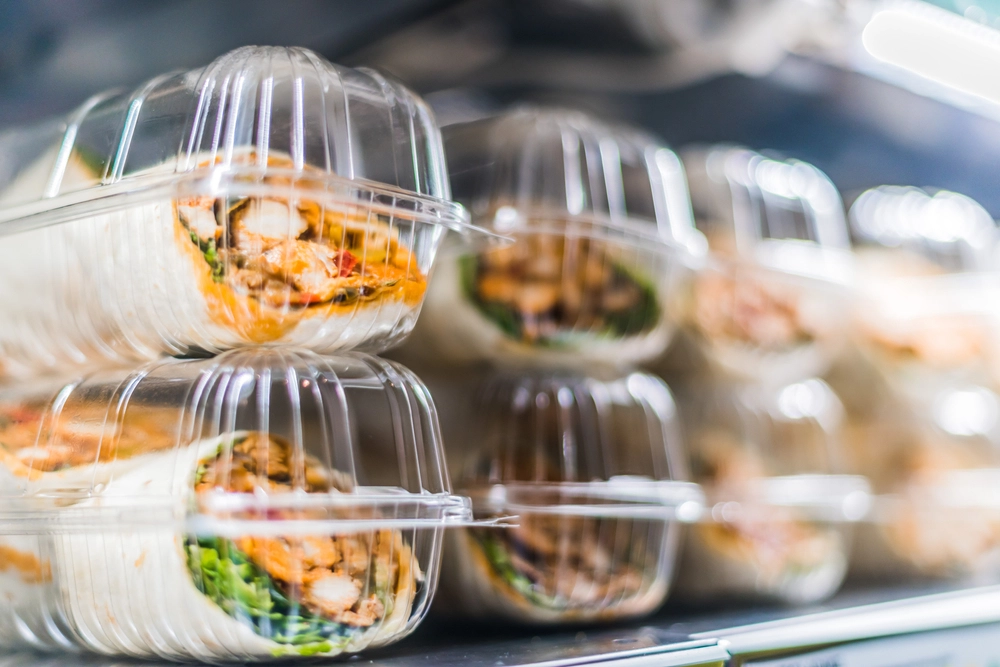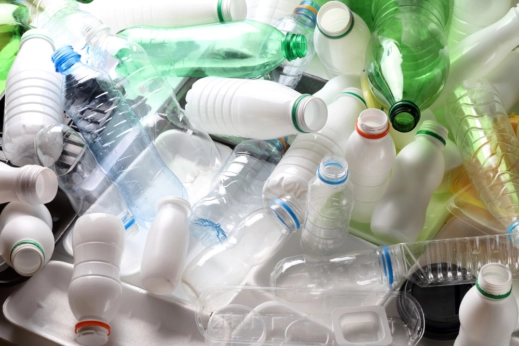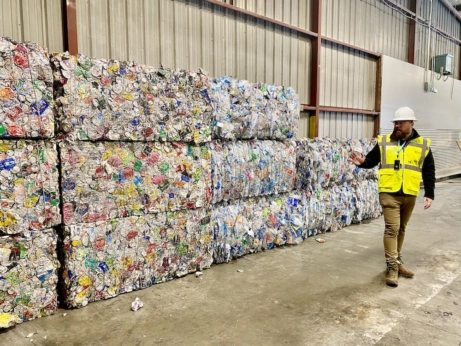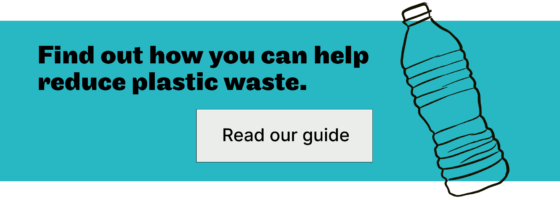We’re swimming in plastic, and often eating it, too. So, what can we do about it?

“Does anyone realize we’re headed toward plastic armageddon?”
That’s how Bradley Aiken of Portland, OR began his response to our call for reader questions about where their food comes from. “My weekly visits to the local farmers’ markets still find an overabundance and reliance on plastic pint containers of berries, single-use plastic bags,and straws! I thought we were done with straws, really?”
Bradley’s lament probably feels familiar to most sustainability-minded consumers. Plastic is truly everywhere. Over just a few decades, it’s become an inescapable part of modern life, permeating nearly every aspect of our lives, from the food we eat (usually wrapped and bagged in plastic and often containing it) to the clothes we wear (60 percent of which are made from plastic) to the microplastics hiding just about everywhere, from clouds to human placentas to the Earth’s most remote corners.
“Plastic packaging is definitely a major source of plastic pollution, and it can seem totally overwhelming to folks when they go out to get food, especially since the great majority of our food is wrapped in plastic,” says Erica Cirino, communications manager for the advocacy group Plastic Pollution Coalition and author of Thicker Than Water: The Quest for Solutions to the Plastic Crisis. “It’s estimated that more than 40 percent of all plastic produced is single-use plastic packaging, which is an astounding amount.”
Hey plastic, don’t touch my cheese
Before the advent of plastic packaging, food was packed in a variety of materials, from natural substances such as gourds and leaves to, most recently, glass bottles and jars, metal cans and tins and paper products. Today, plastic encases a large and growing percentage of our food: A recent survey of Canadian grocery stores found that 71 percent of all produce was packaged in plastic and that baby food had the highest share of plastic packaging, at 76 percent.
There are a few reasons why so much of our food is packaged in plastic. Perhaps most importantly, it’s cheaper to manufacture and transport than alternatives. And as the world grapples with an urgent energy transition, fossil fuel companies jittery about the prospect of decreasing demand for oil are looking to plastics as their next major profit driver—and are on track to triple global plastic production by 2060.
Plastic also gives the impression of cleanliness and sterility, and it has long been thought to extend the shelf life of food, a notion that industry groups tend to emphasize but that recent studies have called into question. “It’s a seemingly hygienic coating for foods to be mass produced, shipped around the world and then end up in the supermarket and eventually in your refrigerator,” says Cirino. “It’s just a very disconnected way of interacting with our foods.”
Worse, she points out, are the health risks of widespread exposure to plastics. Made up of polymers and a dizzying array of chemical additives such as stabilizers, plasticizers, flame retardants and pigments, plastic’s impacts on the human body represent an active area of research. It’s known that many chemicals in plastics, including phthalates and bisphenols, can transfer and leach harmful chemicals that can cause an array of health issues, such as hormone disruption, cancer, diabetes and reproductive disorders. Less well understood are the effects of microplastics, which we can ingest through food and inhale at a rate of about 16 tiny pieces per hour, according to one study.
“It’s a shame that we’re putting it around our food because we’re exposing ourselves, almost inadvertently, to these toxins,” says Cirino. “All these plastics have different chemical risks associated with them. None of them are good.”
Out of sight, out of mind
How did we get here? Quite conveniently, as it turns out. Before the advent of plastics in the 20th century, people produced a fraction of the waste they do today; materials were usually repaired, reused or repurposed. It wasn’t until the post-World War II boom that a culture of disposability began to take hold, as new plastics technology allowed cheap packaging to enter the mainstream, finding a market of consumers increasingly motivated by convenience.
It took some getting used to; historian Susan Strasser recalls how, at first, many consumers washed and saved the tins from disposable TV dinners because they were so unaccustomed to throwing things away after a single use. And it was a transition explicitly driven by the industry. “The future of plastics is in the trash can,” declared Lloyd Stouffer, editor of Modern Packaging Inc., in 1956. By 1963, Stouffer was congratulating plastics industry representatives on their progress. “You are filling the trash cans, the rubbish dumps and the incinerators with literally billions of plastics bottles, plastics jugs, plastics tubes, blisters and skin packs, plastics bags and films and sheet packages—and now, even plastics cans,” he said. “The happy day has arrived when nobody any longer considers the plastics package too good to throw away.”

Photo: Shutterstock
From the outset, industry groups pushed back against regulation and worked to redirect responsibility onto consumers, coining the term “litterbugs” and promoting recycling as the antidote to the rising tide of plastic waste. As a result, global plastic pollution, estimated at around 400 million tonnes per year, became everybody’s problem but theirs.
“The whole idea of disposability is based on this idea that you can make something and not have to clear up after yourself,” says Oliver Franklin-Wallis, an investigative journalist and author of Wasteland: The Secret World of Waste and the Urgent Search for a Cleaner Future. “You go back to the very earliest days of the plastics industry and they have always treated waste as an externality. And when I say that, it means it’s a cost borne by other people … If you are a plastics company, we as the taxpayer, we as society, clean up for you, which means that you get privatized profits and socialized consequences.”
The narrative that puts recycling forward as the solution is a comforting one for consumers. But the reality is much more complicated. For certain plastics, namely PET (as in beverage bottles) and HDPE (as in milk cartons), “we have relatively good end-of-life solutions,” says Franklin-Wallis—although “they’re not always done very effectively, particularly in the [United] States.” But the plastic picture is brimming with films and wraps and other forms that aren’t recyclable under current circumstances, and in general, much less plastic is recycled than any of us would like to believe. (In 2021, the US had a plastic recycling rate of less than six percent, according to one report.)

Logan Harvey, senior general manager of Recology Sonoma Marin, gestures toward bales of plastic at a new recycling facility in Santa Rosa, CA. (Photo: Rose Garrett/Modern Farmer)
One culprit is a confusing labeling system that makes consumers think that things are recyclable when they’re not, leading to optimistic but misguided “wishcycling.” “The plastics industry has known for decades that [the labeling system] doesn’t work. It doesn’t help consumers. What it does is make consumers feel less guilty about buying things,” says Franklin-Wallis. “There’s lots of evidence to show that if you tell people that something is recyclable, they’ll feel less guilty in buying it and therefore they’ll buy more of it.” (Here’s a handy guide to those labels; only numbers 1 and 2 are widely recyclable.)
Less is more
Recycling correctly is one action consumers can take, but while it may feel good, it won’t solve the essential problem of too much plastic material clogging waterways, accumulating in soil and threatening human health. “People are recycling, and they are attempting to do what they were told was the right thing,” says Cirino. But, she says, increasing awareness of the inadequacy of recycling has begun to change people’s attitudes, leading them to seek out solutions such as reuse and refill.
Reusable takeout container systems have proliferated in recent years. Some areas have refill stores, where customers can bring their own bottles to stock up on bulk supplies such as dish soap and browse low-waste products such as metal straws and stainless steel bento boxes. But while consumer changes are an important part of the picture, individuals didn’t start the problem, and they won’t be able to fix it on their own. Effective regulation is key to stopping, as Modern Farmer reader Bradley put it, “plastic armageddon.”
“When you talk to people in the plastics industry, they will act as if consumers want this stuff. But actually consumers are never really given a choice,” says Franklin-Wallis. “If you give consumers the choice to choose more sustainable options, they almost always do that. They want to be able to recycle, they want [to] reuse, they don’t want to do things that are damaging for the planet. So, the challenge is forcing industry to [give people the option].”
Examples of effective legislation include bottle return schemes in countries such as Norway and Germany, which have 95- to 99-percent recycling rates for plastic bottles, and “extended producer responsibility” (EPR) laws, which shift some of the burden onto manufacturers, incentivizing things such as reducing packaging or investing in plastic recovery projects. “The solutions are out there and they’re scaled right now,” says Franklin-Wallis. “Quite often, the issue is either apathy or corporate opposition, and we need to kind of bust through both of those things.”
Throwaway culture is cheap, easy and convenient. Changing our consumer habits and challenging the interests of a powerful global industry is difficult. “There are no easy solutions,” says Franklin-Wallis. “There are only choices.” One choice that’s worth making, however small the impact? Buy less stuff—a lot less, if you’re able—and make do with what you already have.
Click here to read our guide on how you can help reduce plastic waste, from things to do at home to how to support community and policy-level solutions.
***
Thanks to Bradley Aiken for submitting his question for our “Digging In” series. Got a question about where your food comes from? Let us know what you’d like us to investigate next by filling out this form.

I love this series. Please keep going with the reader solutions!
What about farmers using acres of plastic bale wrap? Any good alternatives?
What about all the plastic that farm products are wrapped in (cotton bales) and the black plastic sheeting used in both agricultural and home settings?